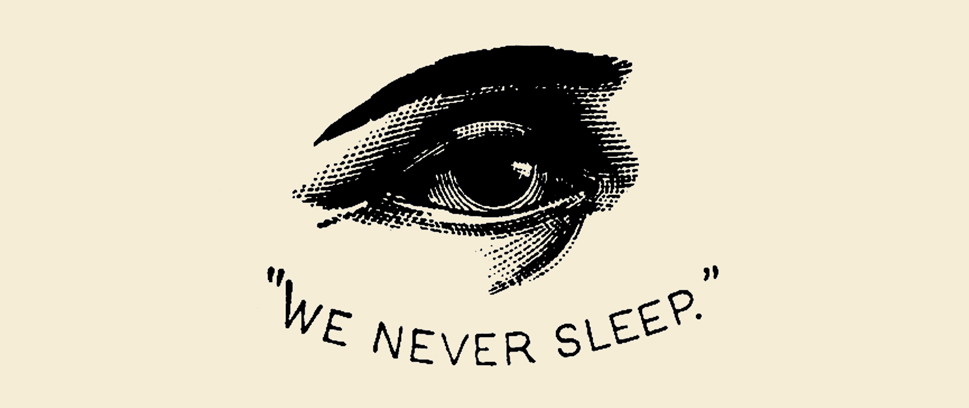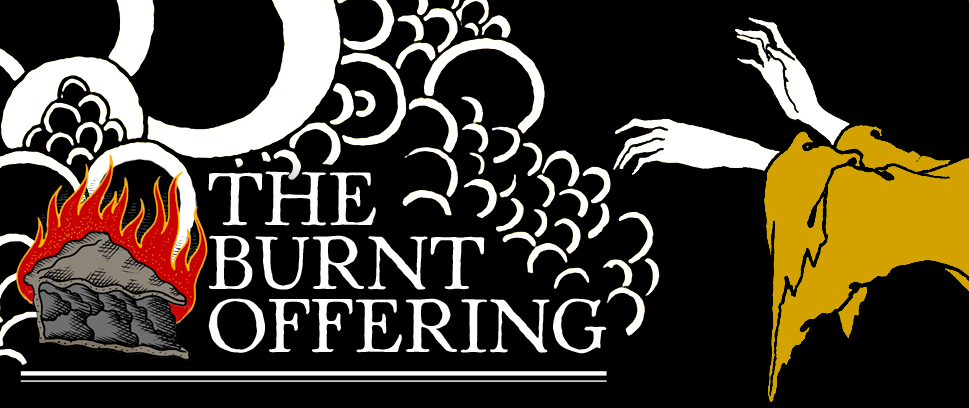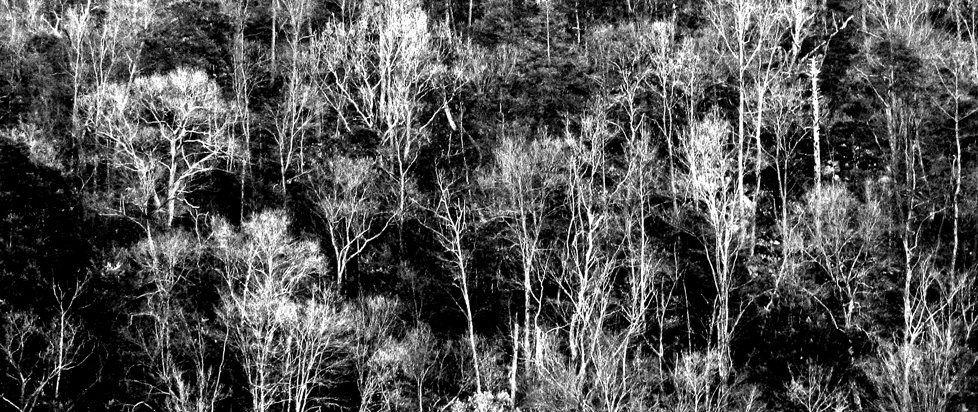
EATEATEATEATEAT: An Interview with Laird Barron
The following is a reprint from Unwinnable Weekly Issue One. If you enjoy what you read, please consider purchasing the issue or subscribing for the year. Many thanks to Laird Barron for his time and to John Coulthart for graciously allowing us to reprint his illustration. We recommend you read Barron’s short story “Bulldozer” before reading this interview.
———
—Then He bites off my shooting hand.
Sometimes, in the evening, a storm will roll in, replacing the sunset with boiling darkness. In that sickly green half-light, as the wind picks up, the air is awash in potential energy – something is about to happen, something raw and furious. The sky quakes and spider webs of purple illumination crackle through the clouds. Rain falls, first in scattered spatters, then in sluicing deluge. Perhaps there is stinging hail, perhaps floodwaters rise, but in the end, the fury subsides into stillness, as though there had never been a storm at all.
The stories of Laird Barron are similar to that storm, except they never relent. There is no calm at the end. The sky grows ever darker and the torrent screams louder until there is nothing but howling blackness.
Now you’re seasoned for his palette. Best run, Pinkerton. You’ve been in the sauce. Chewed up and shat out. And if you live, in twenty years you’ll be another walking Mouth.
“Bulldozer” (2004) lays out the basic recipe of a Laird Barron story. There’s the cosmic bleakness, ample hints to a larger but obscured grand design and supernatural forces with ravenous appetites. The cornerstones of Barron’s work, though, are his characters.
Jonah Koenig, the Pinkerton at the center of the story, is a bulldozer in the original sense of the word – a hard-bitten, hard-drinking, hard-talking regulator who relies on intimidation and the casual use of physical violence to get his job done. About half of Barron’s characters are cut from a similar machismo-soaked cloth. He writes tough guys, gunsels, hired thugs, soldiers, lumberjacks, big-game hunters and more with a studied ease, imbuing them with a complicated vitality. These men are not heroes, to be sure, but in the face of the horrors they eventually encounter, they always inspire a shock of sympathy that would otherwise be missing if they faced less supernatural dilemmas.
“I write what I see, and what I saw during my years in Alaska were a lot of hard-nosed, broken-down people who smoked and drank and fucked to excess,” says Barron. “Koenig is archetypal of a particular subset of my oeuvre in the sense that he’s hyper-capable. He’s a gunfighter with a license to use and abuse violence. Real men and women, civilians, pose no threat to him because he’s above the law. Many of my other protagonists also utilize violence, but they’re drawn more or less three-dimensionally. They suffer predictable consequences for their mistakes. The material world responds to these latter characters in a way you or I might expect were we to choose a similar path.”
Considering the deep ties these heavies have with the pulps and westerns of his childhood reading, Barron’s other protagonists are surprisingly diverse. Old men, single mothers, gay lovers – where Barron’s brutes are blunt instruments, he paints these protagonists with nuance and insight, the tribulations of their lives as much the substance of the story as the horror.
Yet whether they are men of action or unlucky civilians, Barron’s characters share an unfathomable tolerance for suffering, both physical and mental. “I was raised with the mentality that prolonged injury or sickness meant you weren’t a contributor to the family’s bottom line,” he says. “Got the flu, kid? Too bad. Time to cut a hole in the river and haul water, time to harness the huskies, time to work.
“My family wasn’t unusual in that regard. Many of the people I knew during those years were tough as nails. Rural folk who wrapped busted ribs, or pulled their own rotten teeth, or took aspirin to treat walking pneumonia, and soldiered on with the daily routine. You could cry and bellyache all you wished. Nobody gave a shit. Firewood still had to be chopped and meat had to be hunted.”
I’m a Pinkerton man. That means something. I’ve got the gun, a cold blue Colt and a card with my name engraved beneath the unblinking eye. I’m the genuine article. I’m a dead shot, a deadeye Dick. I was on the mark in Baltimore when assassins went for Honest Abe. I skinned my iron and plugged them varmints. Abe should’ve treated me to the theater. Might still be here. Might be in a rocker scribbling how the South was won.
Koenig is on the trail of one Rueben Hicks, lately a strongman in the employ of P.T. Barnum, who has absconded with some of the great showman’s collection of occult items, including a copy of Collin de Plancy’s Dictionnaire Infernal. Hicks also happens to be a serial killer and possible cannibal, leaving a series of hotel rooms across the country defiled with blood and obscene graffiti. Koenig has tracked Hicks to a miserable collection of failed gold mines in California called Purdon. After dealing with whores, gunslingers and a “Satan-worshipping dope fiend,” Koenig learns that Hicks has a benefactor, a Presence that has existed in a nearby cave for millennia. Hicks calls it Belphegor.
Whether that entity is actually the prince of Hell that de Plancy describes or a parasitic alien fungus or something else entirely is never revealed. The story’s recent re-publication in the Lovecraft’s Monsters anthology might imply that it has a tentacled aspect, but Barron is non-committal. “Belphegor, the FatherMother lurking beneath the mountain, may or may not possess tentacles,” he says. “The implication, however, is that it’s an immense ancient entity. It’s also probably squishy and squamous.”
And voracious.
worms, godawful! i am changed! Blessed the sacrament of decay! Glut Obloodyhole O bloodymaggots Obloodybowels O Lordof shite! Fearthegash! iamcomeiamcome

The stories of H.P. Lovecraft, which form the foundation of the Cosmic school of horror, often turn on the idea that mankind is insignificant in the scope of the infinite universe. The dread his stories inspire doesn’t come from something so prosaic as the presence of “evil,” but rather from the revelation that the protagonists are completely helpless in the face of the vastness of existence. The entities that populate those stories aren’t the opponents of man – they don’t even notice man.
Where Lovecraft’s creatures are cosmically indifferent, Barron’s seem to be cosmically hungry. They are aware of humanity, but merely as a source of food. Barron’s favorite term for humankind is provender – fodder. “The idea is central to the existence of carbon-based life. Eat or be eaten, then die and leach into the permafrost that underlies everything,” he says. “Existence is just one long slow-motion massacre.”
An alarming side effect of this theme is that eating and being eaten take on a kind of religious significance – we’re not just dealing with the introduction of a new Alien-esque apex predator into the ecosystem. In “Bulldozer,” Koenig is transfigured by entering Belphegor’s chamber – literally “chewed up and shat out,” to eventually become something like Hicks.
“Matter isn’t destroyed, only transfigured,” says Barron. The act of consumption is an act of communion.
“The thing lurking behind the scenes in ‘Bulldozer’ consumes sapient beings to experience their memories. The ur-beetles in ‘The Forest’ devour sapient beings yet maintain the victims’ consciousness completely intact, rendering the consumed immortal after a fashion.
“That idea of absorption is behind a lot of my stories.”
Time is a ring. Time is a muscle. It contracts.
Structurally, “Bulldozer” is a kind of never-ending hell for Koenig – the story ends right where it begins, cycling the Pinkerton through the same horrific events over and over again, without variation. Langston, a diabolist who appears midway through the story, even tells Koenig that this is the case. “Time is a ring, and in the House of Belphegor that ring contracts like a muscle,” he says.
Fans of HBO’s show True Detective might detect a similarity to Reggie Ledoux’s ominous warning to Detective Rustin Cohle: “Time is a flat circle.”
“[True Detective’s creator Nic] Pizzolato approached me years ago as a fan,” says Barron. “We’ve corresponded infrequently since. He loved The Imago Sequence and Occultation, and has mentioned them positively in interviews. My work seems to have influenced some of his artistic choices. I’ll take it as a compliment.”
Despite a resurgence of interest in weird fiction thanks to True Detective’s use of references to Robert W. Chambers’ perennial horror collection The King in Yellow, Barron dismisses the notion of his chosen genre’s trendiness with similar language. “The big old wheel keeps turning,” he says. “All there is to it.”
For Barron, this circular theory of time fits right in with the theme of experience absorption. “Time consumes itself, or cycles through itself in an endless loop – from Big Bang to heat death and collapse into a single ultra-dense point that eventually destabilizes with another Big Bang, and so on for eternity.”
Perhaps then, “Bulldozer” isn’t told from Koenig’s perspective at all. Perhaps we are merely experiencing his memories, recalled in a loop, by the ancient entity that absorbed them.
“What do you call him?”
“Chemosh. Baal-Peeor. Belphegor. No big deal, the Moabites are dust. They won’t mind if the title gits slaughtered by civilized folks.”
“We’re a fair piece from Moab.”
“Belphegor speaks many tongues in many lands.”
Every time a person reads “Bulldozer,” the loop of time, whatever it may be, plays through again, unaltered. What happens, though, when a reader moves on to the novella Hallucigenia and discovers the graffiti on the walls that could have been written by Hicks? Or when a minor character with the surname Arden in that same story is discovered to have countless relatives populating other tales? As coincidences evolve into connections, the ring of time expands.
“There are several story threads worming their way through the overall narrative,” says Barron. “The Children of Old Leech tales are related to, but distinct from, the transhuman storyline of The Imago Sequence, Hallucigenia, ‘Bulldozer,’ and The Light Is the Darkness. Details are further blurred, because if you read ‘Parallax,’ you’ll receive the hint that these tales occur in two parallel universes. Which is which isn’t mine to divulge.”
Barron points to his 2013 novel The Croning as a summation, of sorts. A few more stories in the cosmic vein are slated for forthcoming anthologies and there is a science fiction/horror novel dealing with the Children of Old Leech in the wings. Beyond that, though, readers have all the cosmic puzzle pieces they’re going to get from Barron for the time being. “The next collection shifts radically away from that genre,” he says. “I’m working on other horror and noir flavored stories for the most part. It has been a busy couple of years.”
Holes close. Holes open. I’m an Opener. They Who Wait live through me.
The more of Barron’s stories you read, the more a pattern begins to emerge. Maybe you’ll notice the statistically improbable number of people who go missing in the Broadsword Hotel or the strange networks of pipes that sinister folk keep burying near standing stones in the wilds of the Pacific Northwest…
For readers of horror, Lovecraft in particular, this kind of mythology building is not new. Lovecraft created his own fictional settings, breathing life into them by modeling them on real New England locales and carefully repeating names to establish a sense of realism. What Lovecraft accomplished was a literary trick, a con that has convinced credulous readers that towns like Arkham and Innsmouth actually exist.
With Barron’s current crop of stories, something else happens. Not only does he echo names, but events as well – a fugue, with variations on the theme. Like Koenig’s circular story trap, Barron’s other characters seem to be siphoned, again and again, through the same drama. How many times has a hapless character found himself at the forbidding foot of Mystery Mountain? How many have spent the night at the Black Ram Lodge? And yet, why do different terrors await different people who have arrived at the same place?
The effect is one of culmination, if not outright continuity. It invites the reader to return, like those characters, to scour for hints and search for revelation.
“For me, it’s organic, something that almost lives and breathes on its own,” says Barron. “It’s also important that the interconnectedness be so complete that readers only pick up the obvious details on the first pass. A good deal needs to operate beneath the surface.
“My mythology involves two major concepts: A) a conspiracy; almost nothing is coincidental; vast and malevolent forces manipulate events; humans are pawns; B) everything in the universe is mated with something else and it’s all traveling at tremendous velocity.
“Sooner or later these objects – planets, stars, bullets, people, whatever – intersect. There’s only fate. You can manipulate your trajectory to some degree, but sooner or later, you’re going to crash into something, or it is going to crash into you.”
———
The Year’s Best Weird Fiction, Volume 1, edited by Laird Barron, will be on shelves in August. He has stories in the new anthologies Nightmare Carnival, Lovecraft’s Monsters and Best Horror of the Year, Volume 6, among others. In April, his most recent collection, The Beautiful Thing That Awaits Us All, won the Stoker Award for superior achievement in a fiction collection.
All quoted text (in italics) is from “Bulldozer,” which is available in Lovecraft’s Monsters, or in Barron’s first short story collection, The Imago Sequence, and Other Stories.
This is the first in a series of stories about contemporary horror. At Laird Barron’s suggestion, author John Langan (Mr. Gaunt & Other Uneasy Encounters, The Wide Carnivorous Sky & Other Monstrous Geographies) will be the next victim…
———
Follow @StuHorvath and @LairdBarron on Twitter. For more on Laird and his work, check out his official site.





